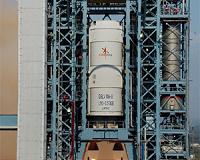 |
Bangalore, India (AFP) April 15, 2010 An Indian rocket showcasing domestically built booster technology crashed soon after take-off on Thursday in a blow to the country's space ambitions, officials said. The launch of the first Indian-made cryogenic powered rocket, a complex technology mastered by just five countries, failed soon after lift-off from India's space centre at Sriharikota in the southeastern state of Andhra Pradesh. "The rocket along with the satellite tumbled from space and plunged into the Bay of Bengal," Indian Space Research Organisation (ISRO) director S. Satish told AFP from Sriharikota. Satish said controllers lost contact with the 50-metre (165-foot) rocket, named GSLV and carrying a 2.2-tonne satellite, and it plunged into the sea eight minutes after the launch. ISRO chairman K. Radhakrishnan told reporters that it appeared the cryogenic engines "did not ignite" but added that data analysis was required to pinpoint the reasons for the failure. It took ISRO scientists 18 years to develop cryogenic motors after its bid to import the technology from Russia in 1992 failed because of opposition from the United States. The powerful booster technology using supercooled liquid fuel is designed to put heavier satellites into high orbits, about 36,000 kilometres (22,000 miles) from Earth. "We will confirm if the main cryogenic engines ignited and then we would put all our efforts to ensure we have the next flight with an indigenous cryogenic engine within an year from now," Radhakrishnan added. Cryogenic boosters have only been successfully developed by the United States, Russia, France, Japan and China. In the past decade, India has bought cryogenic engines from Russia and five of them have been used on missions, but the country wanted to showcase its ability to develop the technology itself, the ISRO said before the launch. India aims to launch its first manned space mission in 2016 and wants to grab a larger share of the multi-billion-dollar market for launching commercial satellites. Last August India's first unmanned moon mission, launched amid much fanfare in 2008, came to an abrupt end when controllers lost contact with the country's lunar craft. But gloom turned to delight in September, when data collected from the mission showed water on the moon, boosting India's credibility. India began its space programme in 1963 and has developed its own satellites and launch vehicles to cut dependence on other countries. Government funding of around 2.8 billion dollars has been secured for an attempt at the country's first manned space mission in 2016.
Share This Article With Planet Earth
Related Links Rocket Science News at Space-Travel.Com
 India Set To Launch Satellite With Cryogenic Rocket Engine
India Set To Launch Satellite With Cryogenic Rocket EngineBangalore (IANS) Apr 15, 2010 India Wednesday readied itself to join the elite space club by firing for the first time its own cryogenic rocket engine to launch an advanced communication satellite. "The 29-hour countdown began 11.27 a.m. at Sriharikota for launching the geo-synchronous satellite launch vehicle (GSLV-D3) Thursday at 16:27 IST with a geo-stationary satellite (GSAT-4) as its main payload," Indian Space Re ... read more |
|
| The content herein, unless otherwise known to be public domain, are Copyright 1995-2010 - SpaceDaily. AFP and UPI Wire Stories are copyright Agence France-Presse and United Press International. ESA Portal Reports are copyright European Space Agency. All NASA sourced material is public domain. Additional copyrights may apply in whole or part to other bona fide parties. Advertising does not imply endorsement,agreement or approval of any opinions, statements or information provided by SpaceDaily on any Web page published or hosted by SpaceDaily. Privacy Statement |